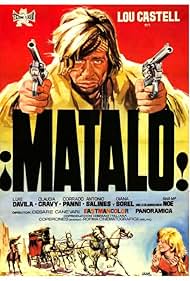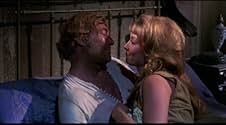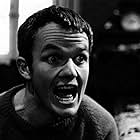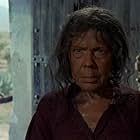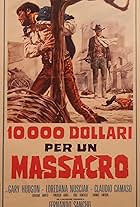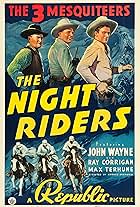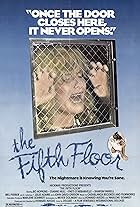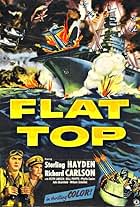A gang of outlaws find themselves in conflict with a mysterious, boomerang-wielding drifter and a widower who arrive in the ghost town they have holed up in.A gang of outlaws find themselves in conflict with a mysterious, boomerang-wielding drifter and a widower who arrive in the ghost town they have holed up in.A gang of outlaws find themselves in conflict with a mysterious, boomerang-wielding drifter and a widower who arrive in the ghost town they have holed up in.
Luis Dávila
- Phil
- (as Luis Davila)
Ana María Mendoza
- Bridget
- (as Anamaria Mendoza)
Antonio Orengo
- Priest at Hanging
- (uncredited)
Joaquín Parra
- Bearded Bandit
- (uncredited)
Diana Sorel
- Blonde Widow
- (uncredited)
- Director
- Writers
- All cast & crew
- Production, box office & more at IMDbPro
Storyline
Did you know
- TriviaA character known as Professor James Rorke appeared in a short, deleted scene wherein he offers Lou Castel's character a meal of biscuits and gravy at the hotel. It can be found on the rare American edition of the DVD.
- ConnectionsReferenced in Let the Corpses Tan (2017)
Featured review
Six years after Sergio Leone's A Fist Full of Dollars created the term "spaghetti western" and the passing of the San Fransisco acid wave of the 60's, someone thought it would be a good idea to combine the two. It would be a showcase for the international talents of Bolivian born actor Lou Castel, Argentinian actor Luis Davila (a.k.a - Luis Devil), Zaire born actress Claudia Gravy, the Italian Corrado Pani and directed by Cesare Canevari. For those familiar with the sultry naiveté of Emmanuelle, Canevari was the director of the first. If you haven't guessed so far, this is all a recipe for disaster.
Speaking with "J" (a friend and I don't mean the John Malkovich currently residing inside of Will Smith) about my reviews, he suggested I should make them my own somehow. I thought I had already done that, but it got me to thinking. I'm not sure if anyone has used this concept before, but here goes. I could rate movies based on a "shot scale". That would be the amount of shots required to enjoy or completely forget about the movie in question. It would only be in use for what I consider to be bad movies (also includes the "good-bad"). So for example, Matalo would require me to down 7 shots of Jagermeister, SoCo (minus lime) or Gentleman Jim D (or a combination of all 3 that would total 7 shots still). So the higher the "shot count", the worse the movie (inverse order to the normal scale). Now back to Matalo.
The whole plot of the movie revolves loosely around the heist of a United States official luggage from a stagecoach in the middle of the desert. We don't get to this point until about 1/2 way through the movie, however. The main character loves the smell of gunpowder, money and women. From the predictable "gore" introduction, I was getting an uneasy feeling in my gut and it wasn't because of the two shots I had quickly guzzled. The "gore" is quite light (even by 1970 standards) and seems almost melodramatically over-theatrical. For an action western, the action is as lively as the ghost town backdrop ; squeaky, rundown, dusty, but with lots of water. I have never seen the desert and water concept/metaphor driven this much into the ground, yet with as little emotion (or sweat) as possible. The director was obviously very influenced by Chappaqua and other "psychedelic" films, as he over uses their effects ad nauseam (literally sometimes). I mean how many times can we show spinning, Outer Limit's tilted framings, and close-ups of thespians with goofy expressions? This is a poor, drunk, blind and deaf man's version of El Topo. It's an Italian import, but definitely not a Ferrari.
90 minutes of that, mixed in with bare-bones dialog and acting (the dialog and acting in this movie share a border with pantomime) is too long I think. The plot could help, right? Not really. Characters coming out of the desert can't help this one, either. The acid rock soundtrack is actually not too bad, however, it is metaphorically alone in the desert with no water. I felt like I was watching Sergio Leone's evil hack clone remaking Tell Your Children (Reefer Madness) for posterity. It's really a smelly, decaying carcass that one million boomerangs cannot save, but it is still in the desert. If you're going to go there, bring the essentials (drugs/alcohol and a gun to shoot yourself afterwards). If you heed my advice, seek Django.
Speaking with "J" (a friend and I don't mean the John Malkovich currently residing inside of Will Smith) about my reviews, he suggested I should make them my own somehow. I thought I had already done that, but it got me to thinking. I'm not sure if anyone has used this concept before, but here goes. I could rate movies based on a "shot scale". That would be the amount of shots required to enjoy or completely forget about the movie in question. It would only be in use for what I consider to be bad movies (also includes the "good-bad"). So for example, Matalo would require me to down 7 shots of Jagermeister, SoCo (minus lime) or Gentleman Jim D (or a combination of all 3 that would total 7 shots still). So the higher the "shot count", the worse the movie (inverse order to the normal scale). Now back to Matalo.
The whole plot of the movie revolves loosely around the heist of a United States official luggage from a stagecoach in the middle of the desert. We don't get to this point until about 1/2 way through the movie, however. The main character loves the smell of gunpowder, money and women. From the predictable "gore" introduction, I was getting an uneasy feeling in my gut and it wasn't because of the two shots I had quickly guzzled. The "gore" is quite light (even by 1970 standards) and seems almost melodramatically over-theatrical. For an action western, the action is as lively as the ghost town backdrop ; squeaky, rundown, dusty, but with lots of water. I have never seen the desert and water concept/metaphor driven this much into the ground, yet with as little emotion (or sweat) as possible. The director was obviously very influenced by Chappaqua and other "psychedelic" films, as he over uses their effects ad nauseam (literally sometimes). I mean how many times can we show spinning, Outer Limit's tilted framings, and close-ups of thespians with goofy expressions? This is a poor, drunk, blind and deaf man's version of El Topo. It's an Italian import, but definitely not a Ferrari.
90 minutes of that, mixed in with bare-bones dialog and acting (the dialog and acting in this movie share a border with pantomime) is too long I think. The plot could help, right? Not really. Characters coming out of the desert can't help this one, either. The acid rock soundtrack is actually not too bad, however, it is metaphorically alone in the desert with no water. I felt like I was watching Sergio Leone's evil hack clone remaking Tell Your Children (Reefer Madness) for posterity. It's really a smelly, decaying carcass that one million boomerangs cannot save, but it is still in the desert. If you're going to go there, bring the essentials (drugs/alcohol and a gun to shoot yourself afterwards). If you heed my advice, seek Django.
- CelluloidRehab
- May 23, 2007
- Permalink
- How long is Matalo! (Kill Him)?Powered by Alexa
Details
- Release date
- Countries of origin
- Language
- Also known as
- Kill Him!
- Filming locations
- Tabernes desert, Almería, Andalucía, Spain(The stage coach robbery)
- Production companies
- See more company credits at IMDbPro
- Runtime1 hour 34 minutes
- Sound mix
- Aspect ratio
- 1.85 : 1
Contribute to this page
Suggest an edit or add missing content

